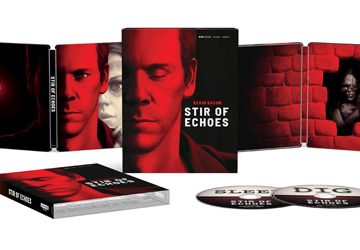This week in Horror movie history, back on Friday, April 28th in 1989, the Slasher flick entitled The Horror Show hit theaters. Also known as Horror House and House III: The Horror Show, produced by Sean S. Cunningham (Friday the 13th 1980, DeepStar Six 1989) and directed by James Isaac (Jason X 2001, Pig Hunt 2008), it was an attempt at creating a new Supernatural serial killer in the vein of such iconic Horror Slashers as the A Nightmare on Elm Street and Friday the 13th franchises.

Featuring Brion James (Blade Runner 1982, The Fifth Element 1997) as sadistic killer Max Jenke, who has mutilated over 100 people with a meat cleaver before he is eventually captured by Lance Henriksen (Aliens 1986, Hard Target 1993), who plays Lucas McCarthy, a dedicated cop. Unwilling to let his reign of terror come to an end, Jenke had been conducting experiments dealing with soul-transference prior to his capture by Lucas. His eventual death by electric chair only serves as a conduit, allowing him to return supernaturally and wreak havoc on McCarthy and his family until a showdown between the two forces commences.
Initially released as its own entity in the United States, separate from the other films in the House franchise, the film has only recently been registered as part of the series’ cannon. Even though this was a great accomplishment for this small Horror series, this fact did not really seem to change the public’s opinion that such a film was a dud in the series.
Beyond its overwhelming use of graphic gore and violence, along with bizzare effects, The Horror Show seemed out-of-place and confusing mostly due to it being shot by two different directors. While one had a cinematic vision for the production, evidently the second had other plans, thus leading some serious creative differences. Though James had his moments of being an amazing, sleazy madman, it was not compelling enough to keep the general public interested in such a film or recurring franchise. While he initially did his best to make the film’s premise attractive, the sad fact remained that, even if more high quality actors were featured in such a film, this would not have fixed the flaws of its story or the blatant difference in production work throughout The Horror Show.

It did not help that the bulk of the cast – which also featured Rita Taggart (The China Syndrome 1979, Mulholland Drive 2001), Dedee Pfeiffer (Falling Down 1993, Cybill series), Aron Eisenberg (Star Trek: Voyager series, Star Trek: Deep Space Nine series), and more – ranged from overly-theatrical at times to just plain awful in their varied roles. However, despite its less than notable acting, the film has the rights to be praised for its overall execution of blood and gore effects; Robert Kurtzman, Greg Nicotero, and Howard Berger really did some superior work when it came to making many scenes a skin-crawling and grotesque experience. For these reasons, The Horror Show is memorable and at least worth a watch for the special effects.
Despite the impressive special effects throughout, critics did not cease to voice their disappointment for the film. Though The Horror Show‘s entire package seemed like the recipe for a great idea to strike some resurgence in the Slasher genre, it was considered too long and too tedious by many critics, making it an overwhelmingly negative response from the media who panned the entire production.
Besides The Horror Show being arguably the worst offering in the House series, it seemed to be nothing more than an attempt at luring in Freddy Krueger enthusiasts. Even though many can and still do appreciate a dose of blood and gore, and healthy injection of profane slurs every now and again, the film came across to many as mere commercial shock value, leaving many to feel like they had wasted money on an overdone gorefest with a lackluster story. While the other offerings in the franchise were more PG when it came to scares and humor, The Horror Show was ultimately just confusing and out of place. In the end, it becomes rather easy to see why The Horror Show was initially released as a stand-alone film rather than a part of the series it was eventually canonically linked to.

Despite all that is wrong with The Horror Show, it is still a film that deserves to be remembered for its use of blood and gore, along with a sense of aesthetic that paved the way for future Horror Slashers. Clearly, that is why the film is considered a cult-classic, and continues to attract unsuspecting new viewers to this day!






No comment